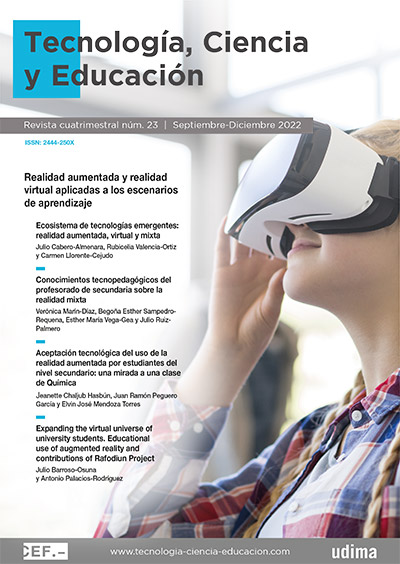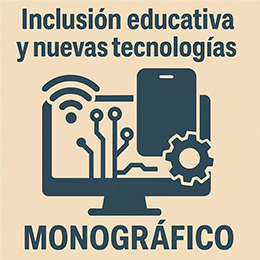Augmented reality in higher education: possibilities and challenges
DOI:
https://doi.org/10.51302/tce.2022.858Keywords:
augmented reality, higher education, educational technology, systematic review, possibilities, challenges, learningAbstract
Currently, there is a growing interest in the use of augmented reality in education. Thus, this study, which systematically examines the use of augmented reality in higher education, has three purposes: (1) to present a synthesis of the available empirical evidence on the use of augmented reality in higher education, (2) to identify the possibilities and challenges of incorporating these technologies in university classrooms, and (3) to determine future trends and prospects for research on augmented reality at the university stage. This study used a systematic review method. Twelve articles that met the specified selection criteria were systematically analysed in order to answer the purpose of the study. The studies reviewed suggest that the use of augmented reality acts as an element that enhances the learning experiences of university students (men and women), however, this is not always the case, as there are studies that have reported limitations in its application, such as the lack of teacher training. The results of the review are discussed in terms of their implications for future research and for improving the training of university teachers in the use of these technologies.
Supporting Agencies
Esta publicación forma parte del proyecto I D i, PID2019-108230RB-I00, financiado por el Ministerio de Ciencia e Innovación y la Agencia Estatal de Investigación (MCIN/AEI/10.13039/501100011033)
Downloads
References
Aguayo, C., Cochrane, T. y Narayan, V. (2017). Key themes in mobile learning: prospects for learner-generated learning through AR and VR. Australasian Journal of Educational Technology, 33(6), 27-40. https://doi.org/10.14742/ajet.3671
Akçayır, M. y Akçayır, G. (2017). Advantages and challenges associated with augmented reality for education: a systematic review of the literature. Educational Research Review, 20, 1-11. https://doi.org/10.1016/j.edurev.2016.11.002
Alkhattabi, M. (2017). Augmented reality as e-learning tool in primary schools' education: barriers to teachers' adoption. International Journal of Emerging Technologies in Learning, 12(2), 91-100.
Azuma, R. T. (1997). A survey of augmented reality. Presence: Teleoperators and Virtual Environments, 6(4), 355-385.
Bacca, J., Baldiris, S., Fabregat, R., Graf, S. y Kinshuk, R. (2014). Augmented reality trends in education: a systematic review of research and applications. Educational Technology & Society, 17(4), 133-149.
Blas Padilla, D., Vázquez-Cano, E., Morales Cevallosi, M. B. y López Meneses, E. (2019). Use of augmented reality apps in university classrooms. Campus Virtuales, 8(1), 37-48.
Brigham, T. J. (2017). Reality check: basics of augmented, virtual, and mixed reality. Medical Reference Services Quarterly, 36(2), 171-178. http://doi.org/10.1080/02763869.2017.1293987
Cabero Almenara, J. y Barroso Osuna, J. (2018). The technological scenarios in augmented reality (AR): educational possibilities in university studies. Aula Abierta, 47(3), 327-335. https://doi.org/10.7821/naer.2016.1.140
Cabero-Almenara, J., Barroso-Osuna, J., Llorente-Cejudo, C. y Fernández Martínez, M.ª M. (2019). Educational uses of augmented reality (AR): experiences in educational science. Sustainability, 11(18). https://doi.org/10.3390/su11184990
Cabero-Almenara, J., Fernández-Batanero, J. M.ª y Barroso-Osuna, J. (2019). Adoption of augmented reality technology by university students. Heliyon, 5(5), 1-9. https://doi.org/10.1016/j.heliyon.2019.e01597
Cabero Almenara, J. y García Jiménez, F. (Coords.). (2016). Realidad aumentada: tecnología para la formación. Síntesis.
Cabero Almenara, J., Vázquez-Cano, E., López Meneses, E. y Jaén Martínez, A. (2020). Formative possibilities of augmented technology. A diachronic study in university scenarios. Revista Complutense de Educación, 31(2), 142-152. https://doi.org/10.5209/rced.61934
Cai, S., Liu, U., Yang, Y. y Liang, J.C. (2019). Tablet-based AR technology: impacts on students' conceptions and approaches to learning mathematics according to their selfefficacy. British Journal of Educational Technology, 50(1), 248-263. https://doi.org/10.1111/bjet.12718
Cheng, K.-H. (2017). Reading an augmented reality book: an exploration of learners' cognitive load, motivation, and attitudes. Australasian Journal of Educational Technology, 33(4), 53-69.
Cózar Gutiérrez, R., Moya Martínez, M.ª V. de, Hernández Bravo, J. A. y Hernández Bravo, J. R. (2015). Tecnologías emergentes para la enseñanza de las ciencias sociales. Una experiencia con el uso de realidad aumentada en la formación inicial de maestros. Digital Education Review, 27, 138-153.
Díaz Noguera, M.ª D., Toledo Morales, P. y Hervás-Gómez, C. (2017). Augmented reality applications attitude scale (ARAAS): diagnosing the attitudes of future teachers. The New Educational Review, 50(4), 215-226.
Durak, H. Y., Saritepeci, M. y Bagdatli Çam, F. (2020). Examination of university students' opinions on use of augmented reality technology in archeology field. Journal of Qualitative Research in Education, 8(1), 156-179. https://doi.org/10.14689/issn.2148-2624.1.8c.1s.8m
Elfeky, A. I. M. y Elbyaly, M. Y. H. (2021). Developing skills of fashion design by augmented reality technology in higher education. Interactive Learning Environments, 29(1), 17-32. https://doi.org/10.1080/10494820.2018.1558259
Engen, B.-K. (2019). Understanding social and cultural aspects of teachers' digital competencies. Comunicar, 61, 9-19. https://doi.org/10.3916/C61-2019-01
Fernández Robles, B. (2018). The use of objects of learning of augmented reality in the university education of primary education. IJERI. International Journal of Educational Research and Innovation, 9, 90-104.
Fombona Cadavieco, J., Pascual Sevillano, M.ª J. y Ferreira Amador, M. F. M. (2012). Realidad aumentada, una evolución de las aplicaciones de los dispositivos móviles. Pixel-Bit. Revista de Medios y Educación, 41, 197-210.
Horra Villacé, I. de la. (2017). Realidad aumentada, una revolución educativa. EDMETIC. Revista de Educación Mediática y TIC, 6(1), 9-22.
Johnson, L., Becker, S., Cummins, M., Estrada, V., Freeman, A. y Hall, C. (2016). NMC Horizon Report: 2016 Higher Education Edition. The New Media Consortium.
Kali, Y., Baram-Tsabari, A. y Schejter A. (Eds.). (2019). Learning in a Networked Society: Spontaneous and Designed Technology Enhanced Learning Communities. Springer's Computer Supported Collaborative Learning Series.
Kamarainen, A. M., Metcalf, S., Grotzer, T., Browne, A., Mazzuca, D., Tutwiler, M. S. y Dede, C. (2013). EcoMOBILE: integrating augmented reality and probeware with environmental education field trips. Computers & Education, 68, 545-556.
Kitchenham, B. (2004). Procedures for Performing Systematic Reviews. Keele University.
Leiva Olivenza, J. J. y Moreno Martínez, N. M. (2015). Tecnologías de geolocalización y realidad aumentada en contextos educativos: experiencias y herramientas didácticas. Revista Científica de Opinión y Divulgación, 31, 1-18.
Lens-Fitzgerald, M. (2009). Augmented Reality Hype Cycle. http://acdc.sav.us.es/pixelbit/images/stories/p46/12.pdf
Marín Díaz, V. (2017). The augmented reality in the educational sphere of student of degree in chilhood education. Case Study. Pixel-Bit. Revista de Medios y Educación, 51, 7-19. http://doi.org/10.12795/pixelbit.2017.i51.01
Martínez Pérez, S. (2020). Tecnologías de información y comunicación, realidad aumentada y atención a la diversidad en la formación del profesorado. Transdigital. Scientific Journal, 1(1), 1-20. https://doi.org/10.56162/transdigital9
Martínez Pérez, S., Fernández Robles, B. y Barroso Osuna, J. (2021). Augmented reality as a resource for training in higher education. Campus Virtuales, 10(1), 9-19.
Moher, D., Liberati, A., Tetzlaff, J. y Altman, D. G. (2009). Preferred reporting items for systematic reviews and meta-analyses: the PRISMA statement. PLoS Medicine, 6(7). https://doi.org/10.1371/journal.pmed.1000097
Moreno Martínez, N. y Leiva Olivencia, J. J. (2017). Formative experiences in the educational use of augmented reality with students of primary education degree at the University of Malaga. EDMETIC. Revista de Educación Mediática y TIC, 6(1), 81-104.
Mystakidis, S., Christopoulos, A. y Pellas, N. (2021). A systematic mapping review of augmented reality applications to support STEM learning in higher education. Education and Information Technologies, 27, 1.883-1.927. https://doi.org/10.1007/s10639-021-10682-1
Orozco, C., Esteban, P. y Trefftz, H. (2006). Collaborative and distributed augmented reality in teaching multi-variate calculus. WBE'06 Proceedings of the 5th IASTED International Conference on Webbased Education. ACTA Press.
Ozdamli, F. y Hursen, C. (2017). An emerging technology: augmented reality to promote learning. International Journal of Emerging Technologies in Learning, 12(11), 121-137.
Pacheco Cortés, A. M. e Infante Moro, A. (2020). La resignificación de las TIC en un ambiente virtual de aprendizaje. Campus Virtuales, 9(1), 85-90.
Poce, A., Amenduni, F., Medio, C. de, Valente, M. y Re, M. R. (2019). Adopting augmented reality to engage higher education students in a museum university collection: the experience at Roma Tre University. Information, 10(12), 375.
Saidin, N., Halim, N. y Yahaya, N. (2015). A review of research on augmented reality in education: advantages and applications. International Education Studies, 8(13), 1-8.
Schmalstieg, D. y Höllere, T. (2016). Augmented Reality. Principles and Practice. Addison-Wesley.
Schmorrow, D., Stanney, K. M. y Reeves, L. M. (2006). Foundations of Augmented Cognition: Augmented Cognition-Past Present and Future. Strategic Analsysis, Inc.
Tecnológico de Monterrey. (2017). EduTrends: radar de innovación educativa 2017.
Thomas, M. y Chinnappan, M. (2008). Teaching and learning with technology: realising the potential. En H. Forgasz, A. Barkatsas, A. J. Bishop, B. Clarke, S. Keast, W. Tiong-Seah y P. Sullivan (Eds.), Research in Mathematics Education in Australasia 2004-2007 (pp. 165-193). Sense Publishers.
Wojciechowski, R. y Cellary, W. (2013). Evaluation of learners' attitude toward learning in ARIES augmented reality environments. Computers & Education, 68, 570-585.
Wu, H.-K., Lee, S. W.-Y., Chang, H.-Y. y Liang, J.-C. (2013). Current status, opportunities and challenges of augmented reality in education. Computers & Education, 62, 41-49. https://doi.org/10.1016/j.compedu.2012.10.024
Yáñez-Luna, J. C. y Arias-Oliva, M. (2018). M-learning: aceptación tecnológica de dispositivos móviles en la formación online. Tecnología, Ciencia y Educación, 10, 13-34. https://doi.org/10.51302/tce.2018.193
Downloads
Published
How to Cite
Issue
Section
License
Copyright (c) 2022 Marta Montenegro-Rueda, José Fernández-Cerero

This work is licensed under a Creative Commons Attribution-NonCommercial-NoDerivatives 4.0 International License.


























